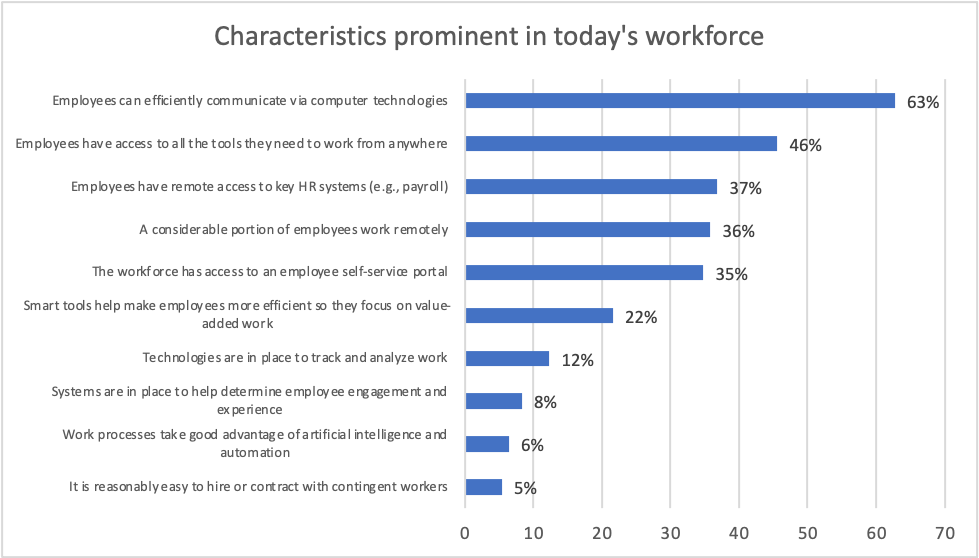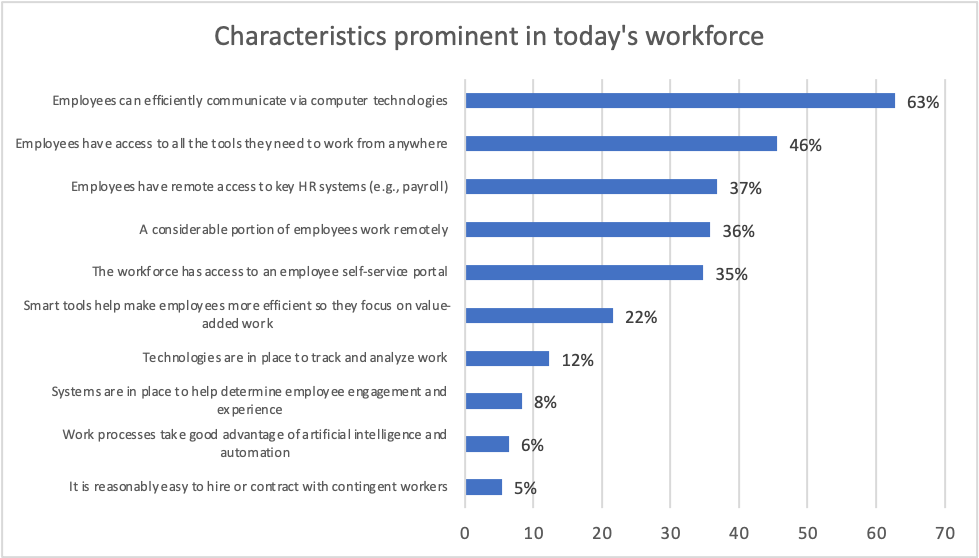The “Digital Workforce in 2021” survey ran in February and March, 2021. We gathered 284 usable complete and partial responses, primarily from HR professionals in virtually every industry vertical.
The survey was conducted by HR.com’s HR Research Institute in partnership with Accurate Background, a leading provider of compliant background checks, drug and health screening, and Form I-9 verifications.
Respondents to the survey were required to have operations in the U.S. but could be headquartered or have additional operations anywhere in the world.
The participants represent a broad cross-section of employers by number of employees, ranging from small businesses with fewer than 50 employees to enterprises with 20,000+ employees.
In this series of blog posts, we take a deep dive into our major findings based on this research and the implications for organizations now working in an increasingly digital environment.
What is the Digital Workforce?
While employers around the world were quickly thrust into operating in a digital environment when the pandemic hit early last year, they have quickly come to a shared understanding of what the “digital workforce” is according to our research.
When we asked respondents to identify the three most important characteristics of a digital workforce, two stood out among the majority:
- Employees have access to all the tools they need to work from anywhere (77%)
- Employees can efficiently communicate via computer technologies (58%)
This may not be so surprising. After all, many organizations were already operating digitally to some extent even before the pandemic and the concept of “telecommuting” has been around for decades.
What may be more surprising, though, is that beyond the recognition of the above two characteristics, agreement became less consistent. The third most cited characteristic was “having smart tools that help make employees more efficient, so they focus on value-added work.” This was cited by only 37% of respondents suggesting that when it comes to the digital workforce, there’s still a certain amount of the unknown at play as employers seek to find the most efficient and effective ways to engage with their remote workers.
How We Define the Digital Workforce
We define the digital workforce as one where workers complete their work using some type of computing device which provides a digital connection so they can collaborate when they need to from wherever they may be, and wherever their colleagues or customers may be.
These digital connections can take many forms including document shared “in the cloud,” video communication platforms, chat services, email, and more.
Another important element of the digital workforce is that it is comprised not just of an organization’s own employees, but may also include freelancers, contractors, and contingent workers.
The Most Important Characteristics of a Digital Workforce
As we’ve seen most agree that the two most prominent elements of a digital workforce are that employees have access to the tools they need to connect with each other and that they can effectively communicate via these technologies. Beyond these characteristics, though, there may be a wide range of other “must haves” depending on the organization, its workforce makeup, the customers it serves and its culture.
Survey question. Hypothetically speaking, what do you believe are the three most important characteristics of a “digital workforce”? (select up to three)

It’s interesting to note that only 10% think that “a considerable portion of employees work remotely” in a digital workforce. It’s also interesting to note that, despite agreement on the most critical elements of a digital workforce, when asked which elements represented a “prominent characteristic” of their own workforce, percentages diminished.
Versus the Most Prominent Characteristics of a Digital Workforce
The only prominent characteristic selected by a majority is that employees can efficiently communicate via computer technologies (63%). It is likely that some organizations were not ready to adapt to the challenges brought on by the pandemic and are struggling to give their workers the tools they need to work from anywhere.
Survey Question. From the list below, which three are the most prominent characteristics of your organization? (select up to three)

The most significant aspect of these findings is that the most significant gap (31%) suggests that many employers are not currently providing employees with the tools they need to work from anywhere. This might be anything from an optimum internet connection, to computer and technical support, to technology to facilitate file sharing and video conferencing.
We believe the gaps we see are a factor in the need for organizations to embrace digital transformation much faster than they had ever anticipated prior to the pandemic. In fact, 65% of respondents indicate that this is the case.
In our next post, we take a look at our second major finding: digital transformations are unlikely to entirely disappear even after the pandemic is over.



